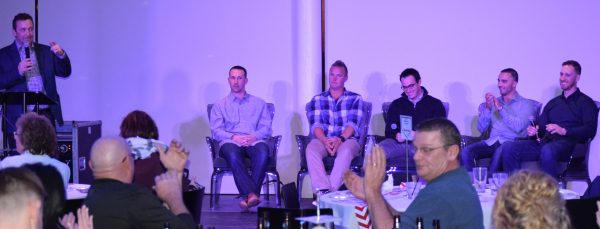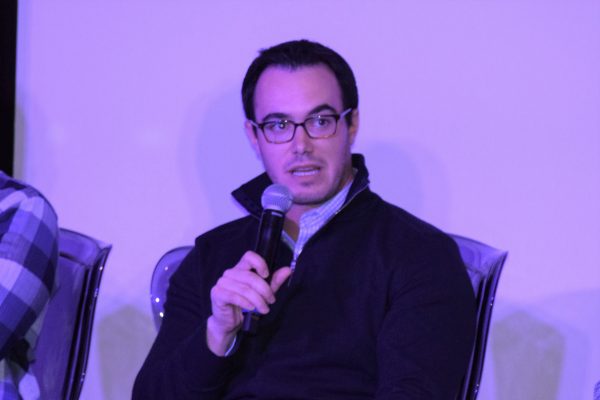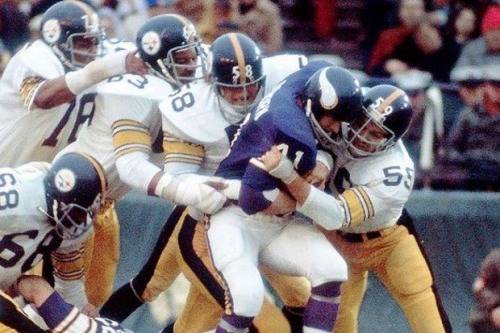Wednesday night, the Cedar Rapids Kernels and their Major League partner, the Minnesota Twins, combined to put on a terrific program for eastern Iowa baseball fans as the Twins once again included a stop in Cedar Rapids for their annual Winter Caravan in conjunction with the Kernels’ annual Hot Stove Banquet.

The Eastbank Venue & Lounge, along the banks of the Cedar River in downtown Cedar Rapids, was a new venue for the event and was a great choice (despite the predominantly purplish lighting, which resulted in a heavy blue hue in virtually every photograph I took at the event, with or without a flash).
There was no shortage of both familiar and less familiar faces among the Winter Caravan panel the Twins sent to town for the evening.
The program was emceed by Twins radio broadcaster Kris Atteberry, who distributed questions to the panel.
Two new faces shared the stage with three that were more familiar to local fans.

New Kernels manager Toby Gardenhire (son of Ron Gardenhire, the longtime manager of the Twins who will be taking the reins in the Detroit Tigers dugout this season) was in attendance, as was his new boss, Jeremy Zoll. The 27-year-old Zoll enters his first season as the Twins’ Director of Minor League Operations.
Atteberry may have had the best line of the night, telling the crowd that his first question for Zoll was going to be the same question the bartender had asked Zoll, “Can I see your ID?”
Kernels hitting coach Brian Dinkelman, who returns to the Kernels again in 2018, was joined by two other familiar faces: former Kernels Mitch Garver and Zack Granite. Both players have now made their big league debuts, finishing the 2017 season with the Twins, and will be going to spring training intent on earning spots on the Twins’ opening day roster.
The featured guests were made available to the media for interviews for a few minutes before the event kicked off and I had the opportunity to speak to Garver and Granite about the paths their careers had taken since their days with the Kernels.
Garver played in 120 games for the 2014 version of the Kernels and hit for a .298 average. His career has steadily progressed each year since.
Granite’s time in Cedar Rapids was cut short by injury in 2014, but he returned in 2015 and immediately hit so well that he earned a quick promotion to Class A Advanced Fort Myers.
Wanting to make the most of what time I had with each player, I asked them both the same question to kick off the interviews.
If you could go back in time, knowing what you know now, and give the Cedar Rapids Kernels version of yourself one piece of advice, what would it be?
“I would say relax,” answered Garver.
“Because when I was at this level, I put a lot of pressure on myself to succeed. Being a senior sign, kind of having that rope get a little bit shorter as my age goes up. It’s like, man, I need to get promoted. I need to prove well at every level. I need to do this and that and I need to do it quickly. And I think that kind of took a toll on me.
“I did have a really good learning process while I was (in Cedar Rapids), but if I could have just told myself, ‘just trust the process, you’re going to get there. Believe in yourself.’ It would have gone a lot smoother.”
But would he have been concerned that might have caused his younger self to relax too much?
“No, I don’t think so. I’ve always been pedal to the metal. I want to do the best I can at everything I do.
“So if I’d have known all that back then, I’d have had the same thought process, going about my work and improving, but I could have gotten (to the Major Leagues) with a little more sleep maybe.”

And what would today’s Zack Granite tell his younger self to do?
“Probably to grow up,” he said.
“I was probably a little immature, took too many at-bats too seriously.
“It’s a long season. I kind of didn’t really know that yet. I’d never played a full season (of professional baseball) yet. There’s so many at-bats in a season and if you get out or make a mistake, it’s on to the next one. That’s how you’ve got to be.
“I feel like that’s the only way to be successful, to clear your mind. Every at-bat is different and don’t take one at-bat into the next. I did that when I was younger. I’ve kind of grown out of that and that’s helped me along the way.”
Was that a tough adjustment for Granite to make, after years where you get so many fewer opportunities to bat in a season?
“It took some time for me to get used to that. Even when I was at Elizabethton, it’s a short season. I never really played a full season until I got to here.
“My first season (in Cedar Rapids) I got hurt, so I didn’t play too much. Then I came back and did pretty well and went to Fort Myers. But even in that short time I was here, I was kind of taking at-bats into the next one.
“I think if I would have done that at an earlier age, took every at-bat separately, I think I would have been more successful.”
The Twins and Kernels will enter their sixth season as affiliates this spring. Seeing young players like Mitch Garver and Zack Granite realize the big league dream they were working so hard to achieve when they were busing around the Midwest League, then come back to town as Major Leaguers, has been one of the best aspects of the Kernels/Twins relationship.
-Steve
P.S. Once again, apologies for the “blue-tinted” photos. I suppose I could have spent a bunch of time editing the color out, but frankly, I just didn’t feel like devoting the time necessary to do that. So let’s just pretend I did it all on purpose, as an homage to the Vikings’ playoff run. 🙂




